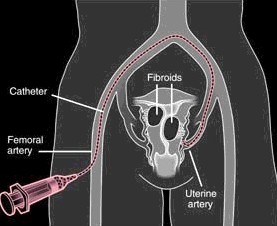


   |
Sharon's Muse.... Let's chat over coffee while I ponder some things |
About Me
My Meez 
Recent Entries
Archives
Personal
Interesting Sites
RAINE'S BLUES
GOLD MOUNTAIN
AGAIN
Need Flashplayer to view. Give time to load.
TOOL & BAD BOYS
Short, Short Ebooks |
Sunday, June 03, 2007 Uterine Fibroid Embolization Types of Fibroids Roz has a post up regarding her experience with fibroids, and it reminded me of a promise I made to myself in 2003 - to talk about my own experience so that women facing the same dilemma would be better informed on the choices they have. Roz has a post up regarding her experience with fibroids, and it reminded me of a promise I made to myself in 2003 - to talk about my own experience so that women facing the same dilemma would be better informed on the choices they have.In the two years prior to the winter of 2003, I had noticed that my menstral cramps were increasing in intensity and often accompanied charley horses in my legs and lower back pains. At times the pain became unbearable, and I had to leave work and go home to settle myself on the floor to find any comfort. I also had to up my dosage of painkillers, and on my worse days, I was taking ten Advils a day, which ultimately damaged my stomach lining. I couldn't even fool myself that the situation was going to get better, and I knew I couldn't endure another fifteen years of insurmountable pain. I consulted my doctor who told me I had fibroids. I was relieved to know there was a reason for the pain and that it was treatable. However, the first (and only) solution out of her mouth was for me to get a hysterectomy. Now, being a diabetic and deathly afraid of any type of surgery involving general anesthesia, I asked if there were alternatives to a hysterectomy. She didn't offer me any, but sent me to an OB-Gyn, who sang the same tune, insisting I either get a hysterectomy or have a myomectomy (see definition below). He almost had me convinced that I was being ridiculous and that having a hysterectomy was no big deal. Thank goodness for the Internet because in the end, it saved me a great deal of medical complications and money. The night after I consulted my primary doctor, I began researching the Net for information on hysterectomies and myopectomies and came across a little known procedure called a uterine fibroid embolization or UFE (see definition below). When I mentioned the procedure to the OB-Gyn, he attempted to dissuade me from it, saying that it wasn't a good solution to my problem, especially since one of my fibroids was now the size of a five-month fetus. But when I did further research, I realized that it was just what I needed, and that women with various sizes of fibroids, even large ones, had had successful embolizations. I contacted the suburban hospital which was a forerunner in performing the procedure and spoke with a consultant over the phone and made a tentative appointment. I was feeling good about taking such a proactive step and defying my doctor, because in the end I am responsible for my own health and I can't just leave it in the hands of third-parties. Even so, I ran into an obstacle with my insurer (Blue Cross/Blue Shield), who would not cover the procedure without a letter of medical necessity from an OB-Gyn or my primary. When I asked my primary for the letter, she refused, telling me that the embolization wasn't a "medical necessity." This, with me having such bouts of painful menstruation that sometimes I would be rolling on the floor crying. No, I wasn't dying, but I was often wishing I were dead. Needless to say I fired that doctor (or just never went back to her). Click Read More! for full article. I finally tracked down another OB-Gyn who examined me, discussed the drawbacks of the procedure. Even though she wasn't a fan of the procedure, she finally gave me a letter of "cautious" recommendation, but it was enough to get me covered. I made an appointment with the hospital and a week or so later, I had the procedure done.  Here is basically what a UFE is: it is still "surgery" in the sense that the procedure is invasive, but instead of dealing with major surgery, you receive a cut just large enough for the radiologist to insert a catheter which is fed into your uterine arteries. Small particles are injected into the catheter which cut off the blood flow to the fibroid(s). Without blood, the fibroid(s) eventually dies. After the procedure, you are admitted for an overnight stay where you are given IV painkillers for the subsequent cramping (and trust me, you will cramp). After you're released, you will be given prescriptions for more painkillers as well as bowel softeners since the other prescriptions tend to make you constipated. After a few days of recovery, I was back at work in less than a week, fully recovered. Recovery time after a hysterectomy would have taken me much longer. Here is basically what a UFE is: it is still "surgery" in the sense that the procedure is invasive, but instead of dealing with major surgery, you receive a cut just large enough for the radiologist to insert a catheter which is fed into your uterine arteries. Small particles are injected into the catheter which cut off the blood flow to the fibroid(s). Without blood, the fibroid(s) eventually dies. After the procedure, you are admitted for an overnight stay where you are given IV painkillers for the subsequent cramping (and trust me, you will cramp). After you're released, you will be given prescriptions for more painkillers as well as bowel softeners since the other prescriptions tend to make you constipated. After a few days of recovery, I was back at work in less than a week, fully recovered. Recovery time after a hysterectomy would have taken me much longer.Going back to my consultation with the second OB-Gyn, I was told that sometimes the fibroid can start growing again, but that hasn't happened in my case. Also, this is not a procedure to consider if you still want kids - although there are noted instances of post-UFE births. As for me, I no longer have debilitating pain; I might become crampish, but this is usually dealt with with just a couple of Aleve (I no longer take Advil). My flow is different, where I have one or two very heavy days as opposed to an even distribution over a four or five-day period. So was it worth it? Heck yeah. And the total cost was about $15,000; half of what I would have had to pay for a hysterectomy, not counting the hospitalization. And this is why I believe the first OB-Gynie was so resistant to the UFE. You see, UFEs aren't performed by OB-Gyns but rather by radiologists. Actually the procedure was initially discovered in France by radiologists who used UFEs as a pre-op procedure to reduce the fibroids in preparation for myomectomies. They discovered that when the blood was cut off to the fibroids, further surgery wasn't needed. Although the procedure was discovered over ten years ago, it is only now really being utilized in the States, which is why coverage isn't automatic. It's still considered experimental. Read more about UFE. If I had not gone with a UFE, I might have opted for the myomectomy, which is the surgical removal of the fibroids only, as opposed to a hysterectomy, which removes the entire uterus. With a myomectomy, women still retain the option of having children; of course, this is no longer possible when a hysterectomy is performed. However, even with hysterectomies, you don't necessarily have to have the ovaries removed, thus avoiding having to deal with hormonal replacement therapy. There are various forms of myomectomies: abdominal; laparoscopic; hysteroscopic; and a new procedure, robotic, which combines abdominal and laparoscopic. Also, read about the various pros and cons of a hysterectomy. These are just starting points in determining what course to take when confronted with fibroid removal. In addition to researching and ultimately discussing it with medical personnel, you may also have to consult your insurer to determine what is and is not covered. Ironically, a friend of mine called me last year asking my advice about UFEs. She had suffered heavy bleeding and pain in her recent periods, and during one course, lost so much blood she fainted. Because of her excessive weight, her doctor didn't want to submit her to the risks of a hysterectomy. Instead, his first recommendation was a UFE. Which points to the procedure finding more acceptance in the medical community, which ultimately may mean automatic coverage, and avoiding the hoops I had to go through in order to get a recommendation. UPDATE: Roz has posted additional information about a couple of fibroid studies in Boston, one of which is a clinical trial of a noninvasive treatment that uses ultrasound to destroy the fibroid.
| ||
| Layout Design by Hajira | Thanks to:Getty Images • Blogspot • Blogskins • |